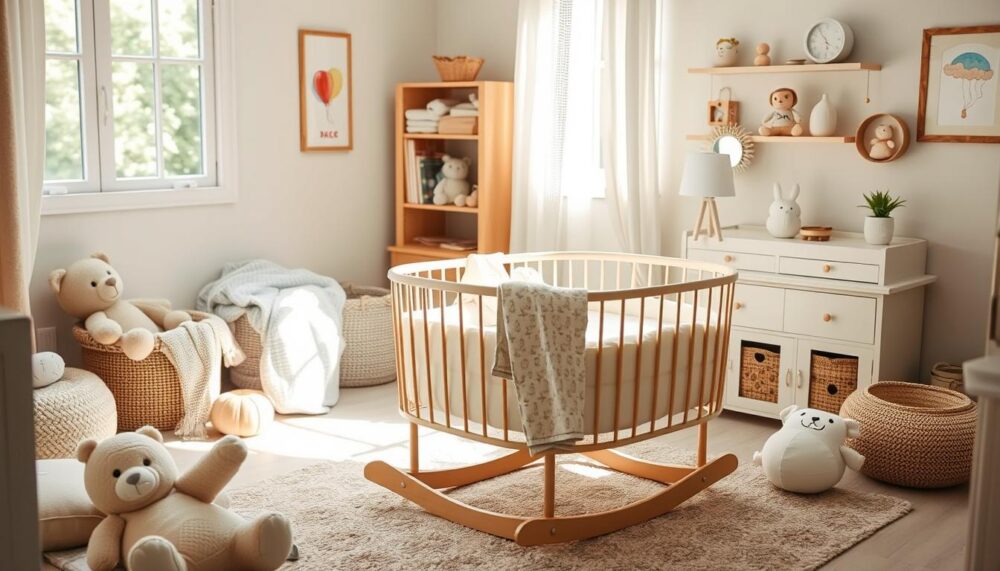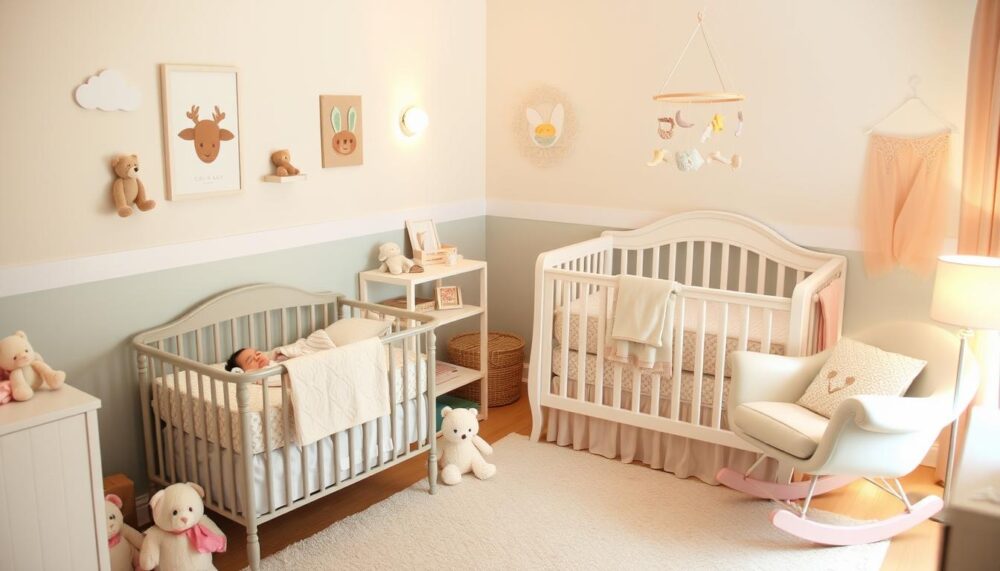
Wondering how long do babies sleep in bassinet? Learn when to transition your little one to a crib with our age-by-age guide and expert safety recommendations for better sleep
As parents, we often wonder how long our newborns should sleep in a bassinet. The right amount of time in a bassinet is key for our babies’ sleep and growth. This guide will help you understand how long your baby should sleep in a bassinet. We’ll also cover important safety tips to keep your baby safe and sound.

Key Takeaways
- Newborns typically sleep 14-17 hours per day, with the majority of that time spent in a bassinet.
- Infants can generally use a bassinet until they reach 5-6 months of age or 20 pounds.
- Adhering to safe sleep guidelines, such as using a firm, flat surface and avoiding loose bedding, is essential for reducing the risk of SIDS.
- Transitioning your baby from a bassinet to a crib should be done gradually to ensure a smooth and comfortable transition.
- Monitoring your baby’s growth and sleep patterns can help you identify when it’s time to move them to a larger sleeping space.
Understanding Bassinet Sleep Basics for Newborns
Being new parents can be both thrilling and daunting. One important thing to think about is how bassinets help your baby sleep well. Knowing the basics of bassinet sleep helps start healthy sleep habits early on.
Benefits of Bassinet Sleep for Young Infants
Bassinets are cozy and safe for newborns. They make your baby feel comfortable and secure. This is great for helping your baby get into a good sleep routine. Plus, being close to you helps with caring for your baby and starting good sleep habits.
Also read: How to Burp a Sleeping Baby: Essential Tips for New Parents
Recommended Sleep Duration by Age
- Newborns (0-3 months): 14-17 hours of sleep per day
- Infants (4-11 months): 12-15 hours of sleep per day
Signs of Healthy Sleep Patterns
Watching your baby’s sleep can tell you a lot about their health. Some signs of good sleep include:
- Consistent sleep-wake cycles
- Smooth transitions between sleep and wakefulness
- Adequate sleep for their age
- Restful, uninterrupted sleep periods
Learning about bassinet sleep basics helps you create a sleep-friendly environment. This supports your baby’s sleep and helps them grow and develop well.
When Should Babies Stop Sleeping in the Bassinet
As your baby grows, it’s time to move them from the bassinet to a crib. But when should babies stop sleeping in the bassinet? and when should a baby move out of the bassinet? The answer depends on a few key factors.
Babies can sleep in a bassinet until they are 4-6 months old. Or until they reach the weight or length limit of the bassinet. Bassinets are made for newborns and younger infants who need a snug space to sleep.
- When your baby starts rolling over or trying to sit up, it’s time for a crib.
- If your baby’s weight or length is too big for the bassinet, it’s safer to move them to a crib.
Switching to a crib is a big step, but it’s crucial for your baby’s growth. By following age and size guidelines, your baby will sleep safely and comfortably as they grow.
“The right time to move your baby from a bassinet to a crib is when they outgrow the bassinet, usually around 4-6 months of age.”

Every baby is different, so watch your child’s needs and growth. If you’re unsure, talk to your pediatrician about when to move your baby to a crib.
Safe Sleep Guidelines and SIDS Prevention in Bassinets
Ensuring your newborn’s safety is key. Bassinets are a great choice for infants. They help lower SIDS risk and encourage good sleep habits.
Essential Safety Features to Look For
When picking a bassinet, look for safety features. Choose ones with strong construction and stable bases. Also, breathable mesh sides are important for airflow.
Make sure the mattress fits well and is firm but comfy. This helps create a safer sleep space.
Creating a Safe Sleep Environment
It’s important to set up the sleep area safely. Place your baby on their back to sleep. Avoid loose bedding and soft objects in the bassinet.
Keep the sleep area free from suffocation hazards. This follows safe sleep guidelines for newborns.
Temperature and Clothing Considerations
Keeping the right temperature and dressing your baby correctly is also crucial. The room should be between 68°F and 72°F (20°C and 22°C). Dress your baby in light, breathable clothes to avoid overheating.
Following these guidelines helps ensure your newborn’s safety in the bassinet phase.
How Long Do Babies Sleep in Bassinet: Age-by-Age Guide
Understanding how long babies sleep in a bassinet depends on their age and developmental stage. Newborns sleep differently than older babies. Here’s a guide to help parents understand bassinet sleep duration at each age.
Newborns (0-3 months): Newborns sleep a lot, up to 17 hours a day. They might sleep 8-12 hours in their bassinet, waking to eat and be comforted.
Early Infancy (3-6 months): At 3-6 months, babies sleep less, about 15 hours a day. They sleep 6-10 hours in their bassinet, with clearer day and night cycles.
| Age | Average Total Sleep per Day | Typical Bassinet Sleep Duration |
|---|---|---|
| Newborns (0-3 months) | Up to 17 hours | 8-12 hours |
| Early Infancy (3-6 months) | Around 15 hours | 6-10 hours |
| Late Infancy (6-12 months) | 12-15 hours | 4-8 hours |
Late Infancy (6-12 months): Babies 6-12 months old sleep less, 12-15 hours a day. They sleep 4-8 hours in their bassinet, more active during the day.
Remember, these are just guidelines. Every baby is different. Watch your baby’s cues and growth to find the best bassinet sleep time for them.

Weight and Size Limitations for Bassinet Use
Welcoming a newborn means setting up a nursery. The bassinet is key, but knowing its weight and size limits is crucial. It keeps your baby safe and comfy.
Understanding Manufacturer Guidelines
Every bassinet has its own rules for weight and size. Following these guidelines is key to safety. Bassinets usually hold babies up to 15 pounds or until they can sit up.
Growth Milestones That Affect Bassinet Safety
As your baby grows, they’ll hit milestones that mean it’s time for a crib. These include:
- Reaching the weight limit set by the bassinet manufacturer
- Pushing up on their hands and knees, indicating they may be able to climb out of the bassinet
- Showing signs of rolling over or breaking free from swaddles, which can pose a suffocation risk in the bassinet
Keep an eye on your baby’s growth. Be ready to move them to a crib when they outgrow the bassinet’s weight capacity or when to switch to crib from bassinet.
| Bassinet Weight Capacity | Bassinet Size Limit |
|---|---|
| Up to 15 pounds | Until baby can push up on hands and knees |
Knowing your bassinet’s weight and size limits helps create a safe sleep space for your newborn. As they grow, they’ll need a crib.

Transitioning Your Baby from Bassinet to Crib
Switching your baby from a bassinet to a crib is both thrilling and challenging for parents. It marks a big change in their sleep space. It’s crucial to do it carefully to make the transition smooth for your baby.
The right time to move your baby can differ. Experts usually suggest doing it between 4-6 months. This is when they grow too big for the bassinet and start moving around more.
- Start the Transition Gradually: Begin by letting your baby get used to the crib a little at a time. Start with naps or short play sessions, then increase the time they spend there.
- Maintain a Familiar Routine: Stick to the bedtime routine you’ve always had. This could be reading a story or singing a lullaby. It helps your baby feel secure in their new bed.
- Create a Comfortable Sleep Space: Make sure the crib has a comfy mattress, fitted sheets, and any sleep aids your baby likes. This could be a white noise machine or a nightlight.
- Be Patient and Responsive: It might take some time for your baby to adjust to the crib. Stay patient, listen to their needs, and support them through this change.
By following these steps and paying attention to your baby’s needs, you can help them make a smooth move from bassinet to crib. This ensures they keep getting the sleep they need to grow and thrive.
“The key to a successful bassinet-to-crib transition is to take it slowly and maintain a sense of familiarity and security for your baby.”

Common Sleep Challenges During the Bassinet Phase
As your infant goes through the bassinet phase, you might face sleep challenges. It’s important to understand and tackle these issues. This way, you can help your baby develop good sleep habits for infants and keep their sleep cycles and patterns on track.
Managing Night Wakings
Newborns often wake up at night for feedings and comfort. To manage these wakings, start a bedtime routine. Make sure your baby gets enough rest during the day. Also, respond quickly to their needs.
Try soothing techniques like rocking, shushing, or a pacifier. These can help your baby fall back asleep.
Addressing Sleep Regression
Sleep regression is a common issue at different developmental stages. It can make your baby wake up more or have trouble sleeping. Stay patient and keep a consistent routine.
Offer extra comfort during these tough times. It can help your baby get through the sleep regression.
Establishing Sleep Routines
- Create a calming bedtime routine, such as a warm bath, gentle massage, and reading a story, to cue your baby’s body that it’s time to sleep.
- Ensure your baby’s bassinet environment is conducive to sleep, with comfortable bedding, appropriate temperature, and minimal distractions.
- Gradually introduce healthy sleep associations, like a favorite stuffed animal or white noise, to help your baby self-soothe and transition to deeper sleep.
By tackling these sleep challenges and setting up good sleep habits for infants, you can make the bassinet phase smoother. Your baby will have fewer sleep disruptions and more restful nights.

Signs Your Baby Has Outgrown Their Bassinet
As your baby grows, their sleep needs change too. It’s important to know when they’ve outgrown their bassinet. Look for signs like their size increase, ability to roll over, and need for more space.
When your baby’s head almost touches the bassinet’s top or their feet almost reach the end, it’s time for a crib. Also, if they roll over or push up a lot, the bassinet might not be safe anymore. Switch to a crib around 4-6 months or when they’re too big for the bassinet.
Every baby is different, so watch your child closely. Pay attention to signs they’ve outgrown their bassinet. This will help you move them to a crib safely and smoothly.
FAQ
When should babies stop sleeping in the bassinet?
Babies usually outgrow their bassinets by 4-6 months. This is when they reach the weight and size limits set by the manufacturer. Moving your baby to a crib is safer and more comfortable as they grow.
How long do babies sleep in a bassinet?
Bassinet sleep times vary. Most babies use them for 4-6 months. Some might stay up to 6-8 months, depending on their growth. Always follow the manufacturer’s guidelines and watch for signs they’ve outgrown it.
What are the benefits of a bassinet for newborns?
Bassinets are cozy and compact, making them great for young babies. They offer easy access for nighttime feedings and help reduce SIDS risk when used safely. They also help establish good sleep habits.
How do I know if my baby is ready to transition from a bassinet to a crib?
Look for signs like rolling over, pushing up on hands and knees, or reaching the bassinet’s weight or height limit. If your baby seems uncomfortable or has trouble sleeping, it’s time to switch.
What safety features should I look for in a bassinet?
Choose a bassinet with a sturdy design, firm mattress, and breathable mesh sides. Make sure it meets current safety standards. Always place your baby on their back to sleep.
How do I create a safe sleep environment in a bassinet?
Remove loose bedding and soft objects. Dress your baby in lightweight clothes and keep the room at a comfortable temperature. Place the bassinet away from hazards like hanging cords.
What are the weight and size limitations for using a bassinet?
Bassinet limits vary by manufacturer. Most have a max weight of 15-20 pounds and height of 25-30 inches. Always follow your bassinet’s specific guidelines for safety.
How can I make the transition from bassinet to crib easier for my baby?
Keep the crib in the same room as the bassinet at first. Use the same bedding and maintain familiar sleep routines. Gradually increase crib time for a smooth transition.
How can I help my baby sleep better in the bassinet?
Establish a consistent bedtime routine and ensure the bassinet is quiet and dark. Use white noise or a gentle rocking motion. Adjust the bassinet as needed to create a comfortable sleep space.
What are some signs that my baby has outgrown their bassinet?
Look for signs like rolling over, pushing up on hands and knees, or if their head almost touches the top. If your baby seems cramped or uncomfortable, it’s time for a crib.







